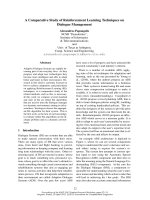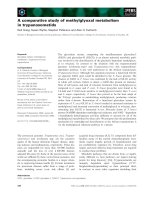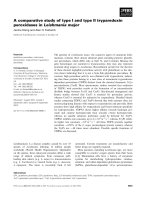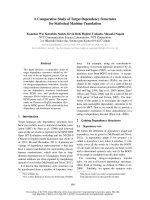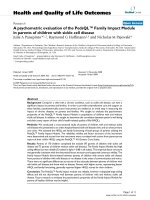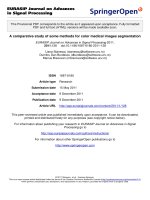báo cáo hóa học:" A comparative study of some methods for color medical images segmentation" doc
Bạn đang xem bản rút gọn của tài liệu. Xem và tải ngay bản đầy đủ của tài liệu tại đây (468 KB, 42 trang )
This Provisional PDF corresponds to the article as it appeared upon acceptance. Fully formatted
PDF and full text (HTML) versions will be made available soon.
A comparative study of some methods for color medical images segmentation
EURASIP Journal on Advances in Signal Processing 2011,
2011:128 doi:10.1186/1687-6180-2011-128
Liana Stanescu ()
Dumitru Dan Burdescu ()
Marius Brezovan ()
ISSN 1687-6180
Article type Research
Submission date 15 May 2011
Acceptance date 9 December 2011
Publication date 9 December 2011
Article URL />This peer-reviewed article was published immediately upon acceptance. It can be downloaded,
printed and distributed freely for any purposes (see copyright notice below).
For information about publishing your research in EURASIP Journal on Advances in Signal
Processing go to
/>For information about other SpringerOpen publications go to
EURASIP Journal on Advances
in Signal Processing
© 2011 Stanescu et al. ; licensee Springer.
This is an open access article distributed under the terms of the Creative Commons Attribution License ( />which permits unrestricted use, distribution, and reproduction in any medium, provided the original work is properly cited.
A comparative study of some methods for color medical
images segmentation
Liana Stanescu
∗
, Dumitru Dan Burdescu
and Marius Brezovan
Faculty of Automation, Computers
and Electronics, University of Craiova,
200440, Romania
∗
Corresponding author:
Email addresses:
DDB:
MB:
Abstract The aim of this article is to study the problem of color medical im-
ages segmentation. The images represent pathologies of the digestive tract such
as ulcer, polyps, esophagites, colitis, or ulcerous tumors, gathered with the help
of an endoscope. This article presents the results of an objective and quanti-
tative study of three segmentation algorithms. Two of them are well known:
the color set back-projection algorithm and the local variation algorithm. The
2
third method chosen is our original visual feature-based algorithm. It uses a
graph constructed on a hexagonal structure containing half of the image pix-
els in order to determine a forest of maximum spanning trees for connected
component representing visual objects. This third method is a superior one
taking into consideration the obtained results and temporal complexity. These
three methods were successfully used in generic color images segmentation.
In order to evaluate these segmentation algorithms, we used error measuring
methods that quantify the consistency between them. These measures allow a
principled comparison between segmentation results on different images, with
differing numbers of regions generated by different algorithms with different
parameters.
Keywords: graph-based segmentation; color segmentation; segmentation eval-
uation; error measures.
1 Introduction
The problem of partitioning images into homogenous regions or semantic en-
tities is a basic problem for identifying relevant objects. Some of the practi-
cal applications of image segmentation are medical imaging, locate objects in
satellite images (roads, forests, etc.), face recognition, fingerprint recognition,
traffic control systems, visual information retrieval, or machine vision.
Segmentation of medical images is the task of partitioning the data into
contiguous regions representing individual anatomical objects. This task is vi-
tal in many biomedical imaging applications such as the quantification of tissue
3
volumes, diagnosis, localization of pathology, study of anatomical structure,
treatment planning, partial volume correction of functional imaging data, and
computer-integrated surgery [1,2].
This article presents the results of an objective and quantitative study of
three segmentation algorithms.
Two of them are already well known:
– The color set back-projection; this method was implemented and tested on
a wide variety of images including medical images and has achieved good
results in automated detection of color regions (CS).
– An efficient graph-based image segmentation algorithm known also as the
local variation algorithm (LV)
The third metho d design by us is an original visual feature-based algo-
rithm that uses a graph constructed on a hexagonal structure (HS) containing
half of the image pixels in order to determine a forest of maximum spanning
trees for connected component representing visual objects. Thus, the image
segmentation is treated as a graph partitioning problem.
The novelty of our contribution concerns the HS used in the unified frame-
work for image segmentation and the using of maximum spanning trees for
determining the set of nodes representing the connected components.
According to medical specialists most of digestive tract diseases imply ma-
jor changes in color and less in texture of the affected tissues. This is the reason
why we have chosen to do a research of some algorithms that realize images
segmentation based on color feature.
4
Experiments were made on color medical images representing pathologies
of the digestive tract. The purpose of this article is to find the best method
for the segmentation of these images.
The accuracy of an algorithm in creating segmentation is the degree to
which the segmentation corresponds to the true segmentation, and so the
assessment of accuracy of segmentation requires a reference standard, repre-
senting the true segmentation, against which it may be compared. An ideal
reference standard for image segmentation would be known to high accuracy
and would reflect the characteristics of segmentation problems encountered in
practice [3].
Thus, the segmentation algorithms were evaluated through objective com-
parison of their segmentation results with manual segmentations. A medical
expert made the manual segmentation and identified objects in the image due
to his knowledge about typical shape and image data characteristics. This
manual segmentation can be considerate as “ground truth”.
The evaluation of these three segmentation algorithms is based on two
metrics defined by Martin et al.: Global Consistency Error (GCE), and Local
Consistency Error (LCE) [4]. These measures operate by computing the degree
of overlap between clusters or the cluster associated with each pixel in one
segmentation and its “closest” approximation in the other segmentation. GCE
and LCE metrics allow labeling refinement in either one or both directions,
respectively.
5
The comparative study of these methods for color medical images segmen-
tation is motivated by the following aspects:
– The methods were successfully used in generic color images segmentation
– The CS algorithm was implemented and studied for color medical images
segmentation, the results being promising [5–8]
– There are relatively few published studies for medical color images of the
digestive tract, although the number of these images, acquired in the di-
agnostic process, is high
– The color medical images segmentation is an important task in order to
improve the diagnosis and treatment activity
– There is not a segmentation method for medical images that produces good
results for all types of medical images or applications.
The article is organized as follows: Section 2 presents the related study;
Section 3 describes our original method based on a HS. Sections 4 and 5
briefly present the other two methods: the color set back-projection and the
LV; Section 6 describes the two error metrics used for evaluation; Section 7
presents the experimental results and Section 8 presents the conclusion of this
study.
2 Related study
Image segmentation is defined as the partitioning of an image into no over-
lapping, constituent regions that are homogeneous, taking into consideration
some characteristic such as intensity or texture [1,2].
6
If the domain of the image is given by I, then the segmentation problem is
to determine the sets S
k
⊂ I whose union is the entire image. Thus, the sets
that make up segmentation must satisfy:
I =
K
k=1
S
k
(1)
Where S
k
∩ S
j
= for k = j and each S
k
is connected [9].
In an ideal mode, a segmentation method finds those sets that correspond
to distinct anatomical structures or regions of interest in the image.
Segmentation of medical images is the task of partitioning the data into
contiguous regions representing individual anatomical objects. This task plays
a vital role in many biomedical imaging applications: the quantification of
tissue volumes, diagnosis, localization of pathology, study of anatomical struc-
ture, treatment planning, partial volume correction of functional imaging data,
and computer-integrated surgery.
Segmentation is a difficult task because in most cases it is very hard to
separate the object from the image background. Also, the image acquisition
process brings noise in the medical data. Moreover, inhomogeneities in the
data might lead to undesired boundaries. The medical experts can overcome
these problems and identify objects in the data due to their knowledge about
typical shape and image data characteristics. But, manual segmentation is
a very time-consuming process for the already increasing amount of medical
images. As a result, reliable automatic methods for image segmentation are
necessary.
7
It cannot be said that there is a segmentation method for medical images
that produces good results for all types of images. There have been studied sev-
eral segmentation methods that are influenced by factors such as application
domain, imaging modality, or others [1,2,10].
The segmentation methods were grouped into categories. Some of these cat-
egories are thresholding, region growing, classifiers, clustering, Markov random
field (MRF) models, artificial neural networks (ANNs), deformable models, or
graph partitioning. Of course, there are other important methods that do not
belong to any of these categories [1].
In thresholding approaches, an intensity value called the threshold must
be established. This value will separate the image intensities in two classes: all
pixels with intensity greater than the threshold are grouped into one class and
all the other pixels into another class. If more than one threshold is determined,
the process is called multi-thresholding.
Region growing is a technique for extracting a region from an image that
contains pixels connected by some predefined criteria, based on intensity infor-
mation and/or edges in the image. In its simplest form, region growing requires
a seed point that is manually selected by an operator, and extracts all pixels
connected to the initial seed having the same intensity value. It can be used
particularly for emphasizing small and simple structures such as tumors and
lesions [1,11].
Classifier methods represent pattern recognition techniques that try to par-
tition a feature space extracted from the image using data with known labels.
8
A feature space is the range space of any function of the image, with the
most common feature space being the image intensities themselves. Classi-
fiers are known as supervised methods because they need training data that
are manually segmented by medical experts and then used as references for
automatically segmenting new data [1,2].
Clustering algorithms work like classifier methods but they do not use
training data. As a result they are called unsupervised methods. Because there
is not any training data, clustering methods iterate between segmenting the
image and characterizing the properties of each class. It can be said that
clustering methods train themselves using the available data [1,2,12,13].
MRF is a statistical model that can be used within segmentation methods.
For example, MRFs are often incorporated into clustering segmentation algo-
rithms such as the K-means algorithm under a Bayesian prior model. MRFs
model spatial interactions between neighboring or nearby pixels. In medical
imaging, they are typically used to take into account the fact that most pixels
belong to the same class as their neighboring pixels. In physical terms, this
implies that any anatomical structure that consists of only one pixel has a
very low probability of occurring under a MRF assumption [1,2].
ANNs are massively parallel networks of processing elements or nodes that
simulate biological learning. Each node in an ANN is capable of performing ele-
mentary computations. Learning is possible through the adaptation of weights
assigned to the connections b etween nodes [1,2]. ANNs are used in many ways
for image segmentation.
9
Deformable models are physically motivated, model-based techniques for
outlining region boundaries using closed parametric curves or surfaces that
deform under the influence of internal and external forces. To outline an object
boundary in an image, a closed curve or surface must be placed first near the
desired boundary that comes into an iterative relaxation process [14–16].
To have an effective segmentation of images using varied image databases
the segmentation process has to be done based on the color and texture prop-
erties of the image regions [10,17].
The automatic segmentation techniques were applied on various imaging
modalities: brain imaging, liver images, chest radiography, computed tomog-
raphy, digital mammography, or ultrasound imaging [1,18,19].
Finally, we briefly discuss the graph-based segmentation methods because
they are most relevant to our comparative study.
Most graph-based segmentation methods attempt to search a certain struc-
tures in the associated edge weighted graph constructed on the image pixels,
such as minimum spanning tree [20,21], or minimum cut [22,23]. The major
concept used in graph-based clustering algorithms is the concept of homogene-
ity of regions.
For color segmentation algorithms, the homogeneity of regions is color-
based, and thus the edge weights are based on color distance. Early graph-
based methods [24] use fixed thresholds and local measures in finding a seg-
mentation.
10
The segmentation criterion is to break the minimum spanning tree edges
with the largest weight, which reflect the low-cost connection between two
elements. To overcome the problem of fixed threshold, Urquhar [25] determined
the normalized weight of an edge using the smallest weight incident on the
vertices touching that edge. Other methods [20,21] use an adaptive criterion
that depends on local properties rather than global ones. In contrast with
the simple graph-based methods, cut-criterion methods capture the non-local
properties of the image. The methods based on minimum cuts in a graph are
designed to minimize the similarity between pixels that are being split [22,23,
26]. The normalized cut criterion [22] takes into consideration self-similarity
of regions. An alternative to the graph cut approach is to look for cycles in a
graph embedded in the image plane. For example in [27], the quality of each
cycle is normalized in a way that is closely related to the normalized cuts
approach.
Other approaches to image segmentation consist of splitting and merging
regions according to how well each region fulfills some uniformity criterion.
Such methods [28,29] use a measure of uniformity of a region.
In contrast, [20,21] use a pairwise region comparison rather than applying
a uniformity criterion to each individual region. A number of approaches to
segmentation are based on finding compact clusters in some feature space [30,
31]. A recent technique using feature space clustering [30] first transforms the
data by smoothing it in a way that preserves boundaries between regions.
11
Our method is related to the works in [20,21] in the sense of pairwise
comparison of region similarity. We use different measures for internal contrast
of a connected component and for external contrast between two connected
components than the measures used in [20,21]. The internal contrast of a
component C represents the maximum weight of edges connecting vertices
from C, and the external contrast between two components represents the
maximum weight of edges connecting vertices from these two components.
These measures are in our opinion closer to the human perception. We use
maximum spanning tree instead of minimum spanning tree in order to manage
external contrast between connected components.
3 Image segmentation using an HS
The low-level system for image segmentation described in this section is de-
signed to be integrated in a general framework of indexing and semantic image
processing. In this stage, it uses color to determine salient visual objects.
The color is the visual feature that is immediately perceived on an image.
There is no color system that is universally used, because the notion of color
can be modeled and interpreted in different ways. Each system has its own
color models that represent the system parameters.
There exist several color systems, for different purposes: RGB (for display-
ing process), XYZ (for color standardization), rgb, xyz (for color normalization
and representation), CieL*u*v*, CieL*a*b* (for perceptual uniformity), HSV
(intuitive description) [2,32].
Figure 1.
12
We decided to use the RGB color space because it is efficient and no con-
version is required. Although it also suffers from the non-uniformity problem
where the same distance between two color points within the color space may
be perceptually quite different in different parts of the space, within a certain
color threshold it is still definable in terms of color consistency. We use the
perceptual Euclidean distance with weight-coefficients (PED) as the distance
between two colors, as proposed in [33]:
PED(e, u) =
w
R
(R
e
− R
u
)
2
+ w
G
(G
e
− G
u
)
2
+ w
B
(B
e
− B
u
)
2
(2)
the weights for the different color channels, w
R
, w
G
, andw
B
verify the condition
w
R
+ w
G
+ w
B
= 1.
Based on the theoretical and experimental results on spectral and real-
world datasets, in [25] it is concluded that the PED distance with weight-
coefficients (w
R
= 0.26, w
G
= 0.70, w
B
= 0.04) correlates significantly higher
than all other distance measures including the angular error and Euclidean
distance.
In order to optimize the running time of segmentation and contour detec-
tion algorithms, we use a HS constructed on the image pixels, as presented in
Each hexagon represents an elementary item and the entire HS represents
a grid-graph, G = (V, E), where each hexagon h in this structure has a corre-
sponding vertex v ∈ V . The set E of edges is constructed by connecting pairs
of hexagons that are neighbors in a 6-connected sense, because each hexagon
has six neighbors.
13
The advantage of using hexagons instead of pixels as elementary piece
of information is that the amount of memory space associated to the graph
vertices is reduced. Denoting by n
p
the number of pixels of the initial image,
the number of the resulted hexagons is always less than n
p
= 4, and then the
cardinal of both sets V and E is significantly reduced.
We associate to each hexagon h from V two important attributes rep-
resenting its dominant color and the coordinates of its gravity center. For
determining these attributes, we use eight pixels contained in a hexagon h: six
pixels from the frontier and two interior pixels. We select one of the two inte-
rior pixels to represent with approximation the gravity center of the hexagon
because pixels from an image have integer values as coordinates. We select
always the left pixel from the two interior pixels of a hexagon h to represent
the pseudo-center of the gravity of h, denoted by g(h).
The dominant color of a hexagon is denoted by c(h) and it represents the
mean color vector of the all eight colors of its associated pixels. Each hexagon
h in the hexagonal grid is thus represented by a single point, g(h), having the
color c(h).
The segmentation system creates an HS on the pixels of the input image
and an undirected grid graph having hexagons as vertices, and uses this graph
in order to produce a set of salient objects contained in the image. In order to
allow an unitary processing for the multi-level system at this level we store,
for each determined component C:
– an unique index of the component;
14
– the set of the hexagons contained in the region associated to C;
– the set of hexagons located at the boundary of the component.
In addition for each component a mean color of the region is extracted.
Our HS is similar to quincunx sampling scheme, but there are some impor-
tant differences. The quincux sample grid is a sublattice of a square lattice that
retains half of the image pixels [34]. The key point of our HS, that also uses half
of the image pixels, is that the hexagonal grid is not a lattice because hexagons
are not regular. Although our hexagonal grid is not a hexagonal lattice, we
use some of the advantages of the hexagonal grid such as uniform connectiv-
ity. In our case, only one type of neighborhood is possible, sixth neighborhood
structure, unlike several types as N4 and N8 in the case of square lattice.
3.1 Algorithms for computing the color of a hexagon and the list of hexagons
with the same color
The algorithms return the list of salient regions from the input image. This list
is obtained using the hexagonal network and the distance between two colors
in the RGB color space. In order to obtain the color of a hexagon a procedure
called sameVertexColour is used. This procedure has a constant execution time
because all calls are constant in time processing. The color information will
be used by the procedure expandColorArea to find the list of hexagons that
have the same color.
15
3.1.1 Determination of the hexagon color
The input of this procedure contains the current hexagon h
i
, L
1
—the colors
list of pixels corresponding to the hexagonal network: L
1
= {p
1
, . . . , p
6n
}. The
output is represented by the object crtColorHexagon.
Procedure sameVertexColour (h
i
, L
1
) initialize
crtColorHexagon;
determine the colors for the six vertices of hexagon h
i
determine the colors for the two vertices from interior of hexagon h
i
calculate the mean color value meanColor for the eight colors of vertices;
crtColorHexagon.colorHexagon <- meanColor;
crtColorHexagon:sameColor <- true;
for k <- 1 to 6 do
if colorDistance(meanColor, colorVertex[ k]) > threshold then
crtColorHexagon:sameColor <- false;
break;
end
end
return crtColorHexagon;
In the above function, the threshold value is an adaptive one, defined as the
sum between the average of the color distances associated to edges (between
the adjacent hexagons) and the standard deviation of these color distances.
16
3.1.2 Expand the current region
The function expandColourArea is a depth-first traversing procedure, which
starts with an specified hexagon h
i
, pivot of a region item, and determines
the list of all adjacent hexagons representing the current region containing h
i
such that the color dissimilarity between the adjacent hexagons is below a
determined threshold.
The input parameters of this function is the current region item, index-
CrtRegion, its first hexagon, h
i
, and the list of all hexagons V from the hexag-
onal grid.
Procedure expandColourArea (h
i
, crtRegionItem, V )
push(h
i
);
while not(empty(stack)) do
h <- pop();
for each hexagon h
j
neighbor to h do
if not(visit (V [h
j
])) then
if colorDistance(h, h
j
) < threshold then
add h
j
to crtRegionItem
mark visit (V [h
j
])
push (h
j
)
end
end
end
17
end
The running time of the procedure expandColourArea is O(n) where n is
the number of hexagons from a region with the same color [35].
3.2 The algorithm used to obtain the regions
The procedures presented above are used by the listRegions procedure to ob-
tain the list of regions.
This procedure has an input which contains the vector V representing the
list of hexagons and the list L
1
.
The output is represented by a list of colors pixels and a list of regions for
each color.
Procedure listRegions (V , L
1
)
colourNb <- 0;
for i <- 1 to n do
initialize crtRegionItem;
if not(visit( h_ i)) then
crtColorHexagon <- sameVertexColour (L
1
, h
i
);
if crtColorHexagon.sameColor then
k <- findColor(crtColorHexagon.color);
if k < 0 then
add new color ccolourNb to list C;
k <- colourNb++;
18
indexCrtRegion <- 0;
else
indexCrtColor <- k;
indexCrtRegion<-
findLastIndexRegion(index CrtColor);
indexCrtRegion++;
end
h
i
.indexRegion <- indexCrtRegion;
h
i
.indexColor <- k;
add h
i
to crtRegionItem;
expandColourArea(h
i
, L
1
,V,indexCrtRegion, indexCrtColor,
crtRegionItem);
add new region crtRegionItem to list of element k from C
end
end
end
The running time of the procedure list Regions is O (n)
2
, where n is the
number of the hexagons network [35].
Let G = (V, E) be the initial graph constructed on the HS of an image. The
color-based sequence of segmentations, S
i
= (S
0
, S
1
, . , S
t
), will be generated
by using a color-based region model and a maximum spanning tree construc-
tion method based on a modified form of the Kruskal’s algorithm [36].
19
In the color-based region model, the evidence for a boundary between two
regions is based on the difference between the internal contrast of the regions
and the external contrast between them. Both notions of internal contrast or
internal variation of a component, and external contrast or external variation
between two components are based on the dissimilarity between two colors
[37]:
ExtV ar(C
, C
) = max
(h
i
,h
j
)∈cb(c
,c
)
w ( h
i
, h
j
) (3)
IntV ar(C) = max
(h
i
,h
j
)∈c
w ( h
i
, h
j
) (4)
where cb(C
, C
) represents the common boundary between the components
C
and C
and w is the color dissimilarity between two adjacent hexagons:
w(h
i
, h
j
) = PED(c(h
i
), c(h
j
)) (5)
where c(h) represents the mean color vector associated with the hexagon h.
The maximum internal contrast between two components is defined as
follows [37]:
IntV ar(C
, C
) = max(IntV ar(C
), IntV ar(C
)) + r (6)
where the threshold r is an adaptive value defined as the sum between the
average of the color distances associated to edges and the standard deviation,
r = µ + σ.
20
The comparison predicate between two neighboring components C
and
C
determines if there is an evidence for a boundary between them [37].
diff
col
(C
, C
) =
true, ExtV ar(C
, C
) > IntV ar(C
, C
)
false, ExtV ar(C
, C
) ≤ IntV ar(C
, C
)
(7)
The color-based segmentation algorithm represents an adapted form of a
Kruskal’s algorithm and it builds a maximal spanning tree for each salient
region of the input image.
4 The color set back-projection algorithm
Color sets provide an alternative to color histograms for representing color
information. Their utilization is based on the assumption that salient regions
have not more than few equally prominent colors [38].
The color set back-projection algorithm proposed in [38] is a technique for
the automated extraction of regions and representation of their color content.
The back-projection process requires several stages: color set selection,
back-projection onto the image, thresholding, and labeling. Candidate color
sets are selected first with one color, then with two colors, etc., until the salient
regions are extracted. For each image quantization of the RGB color space at
64 colors is performed.
The algorithm follows the reduction of insignificant color information and
makes evident the significant CS, followed by the generation, in automatic
way, of the regions of a single color, of the two colors, etc.
21
For each detected region the color set, the area and the localization are
stored. The region localization is given by the minimal bounding rectangle.
The region area is represented by the number of color pixels, and can be
smaller than the minimum bounding rectangle.
The image processing algorithm computes both the global histogram of the
image, and the binary color set [7,32]. The quantized colors are stored in a
matrix. To this matrix a 5 × 5 median filter is applied which has the role of
eliminating the isolated points. The process of regions extraction is using the
filtered matrix and it is a depth-first traversal described in pseudo-code in the
following way:
Procedure FindRegions (Image I, colorset C)
InitStack(S)
Visited = ∅
for *each node P in I do
if *color of P is in C then
PUSH(P)
Visited <- Visited ∪ P
while not Empty(S) do
CrtPoint <- POP()
Visited <- Visited ∪ CrtPoint
For *each unvisited neighbor S of CrtPoint do
if *color of S is in C then
Visited <- Visited ∪ S
22
PUSH(S)
end
end
end
* Output detected region
end
end
The total running time for a call of the procedure FindRegions (Image I,
colorset C) is O(m
2
× n
2
) where m is the width and n is the height of the
image [7,32].
5 Local variation algorithm
This algorithm described in [20] is using a graph-based approach for the image
segmentation process. The pixels are considered the graph nodes so in this way
it is possible to define an undirected graph G = (V, E) where the vertices v
i
from V represent the set of elements to be segmented. Each edge (v
i
, v
j
) be-
longing to E has associated a corresponding weight w(v
i
, v
j
) calculated based
on color, which is a measure of the dissimilarity between neighboring elements
v
i
and v
j
.
A minimum spanning tree is obtained using Kruskal’s algorithm [36]. The
connected components that are obtained represent image regions. It is sup-
posed that the graph has m edges and n vertices. This algorithm is described
also in [39] where it has four major steps that are presented below:
23
Sort E=(e
1
, , e
m
) such that |e
t
| < |e
t
| ∀ t < t
Let S
0
= ({x
1
}, , {x
n
}) be each initial cluster containing only
one vertex.
For t=1, ,m
Let x
i
and x
j
be the vertices connected by e
t
Let C
t−1
xi
be the connected component containing point x
i
on
iteration t-1 and
l
i
= max
mst
C
t−1
xi
be the longest edge in the minimum
spanning tree of C
t−1
xi
. Likewise for l
j
.
Merge C
t−1
xi
and C
t−1
xj
if
|e
t
| < min{l
i
+
k
C
t−1
xi
, l
j
+
k
C
t−1
xj
} where k is a constant.
S = S
m
The existence of a boundary between two components in segmentation is
based on a predicate D. This predicate is measuring the dissimilarity between
elements along the boundary of the two components relative to a measure of
the dissimilarity among neighboring elements within each of the two compo-
nents. The internal difference of a component C ⊆ V was defined as the largest
weight in the minimum spanning tree of a component MST(C, E) :
Int(C) = max
e∈MST (CE)
w(e) (8)
A threshold function is used to control the degree to which the difference
between components must be larger than minimum internal difference. The
24
pairwise comparison predicate is defined as:
D(C
1
, C
2
) =
true, ifDif (C
1
, C
2
) > MInt(C
1
, C2)
false, otherwise
(9)
where the minimum internal difference Mint is defined as:
MInt(C
1
, C
2
) = min(Int(C
1
) + τ(C
1
), Int(C
2
) + τ(C
2
)) (10)
The threshold function was defined based on the size of the component: τ(C) =
k/|C|. The k value is set taking into account the size of the image. For images
having the size 128 × 128 k is set to 150 and for images with size 320 × 240
k is set to 300. The algorithm for creating the minimum spanning tree can
be implemented to run in O(m log m) where m is the number of edges in the
graph. The input of the algorithm is represented by a graph G = (V, E) with
n vertices and m edges. The obtained output is a segmentation of V in the
components S = (C
1
, . , C
r
). The algorithm has five major steps:
1. Sort E into π = (o
1
, , o
tπ
) by non-decreasing edge weight
2. Start with a segmentation S
D
, where each vertex v
i
is in own
component
3. Repeat step 4 for $q = 1, , m$
4. Construct S
q
using S
q−1
and the internal difference. If v
i
and v
j
are in disjoint components of S
q − 1
and the weight of the
edge between v
i
and v
j
is small compared to the internal


